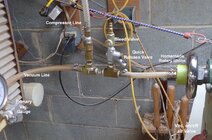There seem to be several ways to reverse chuck a bowl for final clean up, especially tenon shaping or removal. For someone who allows some bowls to warp out of round, which of these should be the priority?
- Jam chuck, with final tenon clean up using a carving tool. Tail stock impedes access for some work.
- Longworth chuck (genius), but seems limited to round bowls?
- Vacuum chuck (expensive, but worth it compared to others? I do have an air compressor)
- Cole jaws, limited to round?
Green wood or dry? Twice turned and round or rough turned and warped?
I have cole jaws, vacuum chucks/pump, and have made many jam chucks. But with the way I usually work now, I almost never use them.
Note: This way is probably not useful for twice-turned green wood. (So if that's the plan, skip now to the next message.)
But for turning from dry wood, I work in a completely different way. I mount a screw chuck to the flat top of the blank, turn the outside, the bottom, and the foot, then inside the foot I make a shallow recess to fit chuck jaws, usually 50mm. I turn some detail around and inside the recess, making sure it's perfectly smoothed inside. I then smooth, sand, and apply finish to the entire outside and the bottom. The bottom side is now completely finished.
Then, I remove it from the screw chuck, turn the piece around and hold by the recess and turn, smooth, and apply finish to the rim and the inside/top. Now both top and bottom are completely done. No need to reverse and clean up anything. No worrying about how to hold an oddly shaped piece. No vacuum chuck, cole jaws, jam chuck needed - once the finish cures the piece is immediately ready to give away, auction, donate, or even sell, if you're into that.
I've been working this way for years for everything from 6" bowls to 20" platters. For me, it saves a lot of time and effort.
Some turning police don't like the idea of leaving the recess in the bottom but I do. It adds detail, people are surprised and pleased when they turn the piece over to look at the bottom, As a bonus the recess creates a great little protected "shadow box" ring to sign the work. I even have a few "converts" now working the same way.
The real beauty of this method is once you turn the piece over, turn/smooth/finish to the top side, it's done.
As I said, this method may not be the best for wet wood turners. But since I almost never turn wet wood, it works for me. Some examples:
Cherry (made for a girl who lost two family members, her brother and mother)

Olive, from a special slab

14" and 19.5" Sapele platters, in use at the Jordan household.

19" sapele platter with 3-axis base - recess on this one is the circle of arcs inside the three little triangular-ish sections.
The recess doesn't need to be deep to hold, just 1/8" or so. I have NEVER had a piece come off the lathe.
The very wide foot makes it quite stable. Undercut on the rim makes it easy to lift and carry, even loaded with goodies.
I turned this about 10 years ago if I remember correctly. Was auctioned for charity.
(One point: it is advisable to turn a piece like this with finesse rather than heavy force. No catches allowed.)

JKJ










